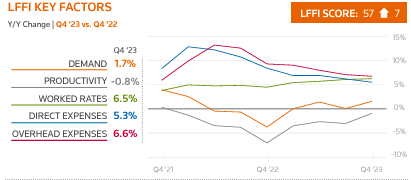In-house legal departments are seeing sharp fee increases from law firms: a report from the Thomson Reuters Institute showed that fee earner rate increases averaged 6.5 percent in the first quarter of 2024, up one percentage point from the same period the previous year.

For clients struggling with expense challenges, rate increases may be hard to stomach. This is especially true if they feel like they aren’t getting additional value for their money.
Legal departments are feeling even greater urgency to manage increasing expenses from law firms. And this isn’t just fee increases. As they start to dig deeper, many law departments are finding additional sources of bloat in law firm invoices. They are also finding ways to reduce this bloat so that they are paying for the value they receive.
Increases in law firm invoices
While some practice areas or firms may have kept fees flat, others are pricing in substantial rises, prompting some in-house teams to push back on rate increases and start looking more closely at their invoices. According to the Thomson Reuters Institute State of the Corporate Law department 2024 report, two-thirds of corporate law departments globally said they intend to seek greater discounts on law firm rates in the coming year.
What factors are causing higher fees?
There are three main sources of bloating on law firm invoices. These factors result in in-house legal departments paying more than they expect to, without seeing additional value for their money. These sources are:
Rate increases:
Law firms are certainly within their rights to request fee increases, and they should be compensated for the value they deliver. Sometimes, though, these increases don’t reflect the market rate. They can also affect clients unevenly – if you are a long-term loyal client, you may be paying increases on top of already inflated rates.
Rate errors:
Sometimes when legal departments agree to a certain rate, that rate doesn’t make it into the firm’s timekeeping system correctly. This can result in clients paying a higher rate than they agreed to for certain fee earners. This is usually the result of human error and not of bad intentions on the part of the law firm. Still, these incorrect rates can add up significantly. Rate increase and other billing guideline errors can add the equivalent of up to £300,000 in annual bloat for a £800 million company, according to a report from Forrester.
Other billing guideline errors:
Legal departments agree to pay for certain costs and expenses related to their matters, but they also refuse to pay for others. Common examples of excluded expenses are copies, scans, overnight messaging, word processing, and document submissions. Through human error, firms may charge for these anyway. And because manual review of invoices is tedious and time consuming, many legal departments pay these charges despite their violating the guidelines.
Right-sizing law firm invoices
Many legal departments have experienced all these sources of bloat. The next question is, “What do we do about it?” That is, how can we systematically manage these invoices so we are paying for what we agreed to and ensuring our rates match the value we’re receiving?
Data:
There are two sets of data that are important to improve your overall spend management. The first is understanding what you’re paying now and what you’ll pay in the future, by matter and by law firm. This will help you understand the scale of your overall fee increases. The second critical data set is industry benchmarks. What are other companies of your size paying for similar work in similar geographies? Being able to compare against your past payment and against the market helps you assess whether rates are appropriate.
Process:
Once you’ve agreed to rates and billing guidelines that both you and your firms believe adequately reflect the value they provide, it’s time to manage against that agreement. Establish a process to check each invoice against your billing guidelines. Establish another process to continually review fee increase requests against market benchmarks. These processes will help your legal department pay an appropriate price for each invoice and stay in line with market rates in the future.
Finding data and establishing processes
A busy legal department reviews and pays hundreds of invoices each year from dozens of outside law firms. While you may know that it’s important to compare your invoices against benchmarks and billing guidelines, you also may recognise the challenges in the execution. Finding the data and finding the time to enforce billing guidelines are both significant challenges if you’re handling them on your own. It certainly isn’t reliable to poll your network on every matter type to see what they’re spending. And manual review of every invoice against billing guidelines isn’t sustainable or effective for most lean legal departments.
To perform effective spend management at scale, most modern legal departments are implementing tools to help them find benchmarks and review invoices thoroughly. Tools like Legal Tracker from Thomson Reuters relieve the administrative burden on the team, remove much of the risk of human error, and provide reliable data that helps you ensure you’re paying for the value you receive under the terms you agreed to.
___________________________________________________________
Are you looking to improve your legal department’s control over law firm invoices? Learn more about how Legal Tracker from Thomson Reuters can help you strengthen spend management and operations.




